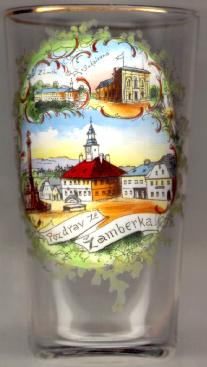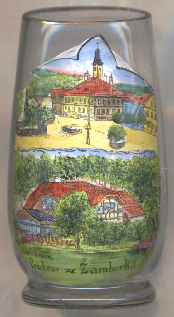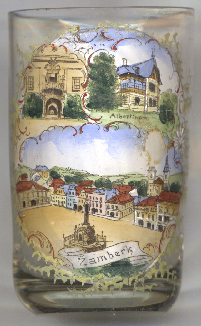

|
| ČESKÁ REPUBLIKA | CZECH REPUBLIC |
| Pardubický kraj | Pardubice region |
| Okres: Ústí nad Orlicí |
Žamberk (German: Senftenberg) is situated at an elevation of 418 m in the valley of the Divoká
Orlica (Wilde Adler), about 14 km northeast of the district town Ústí nad Orlicí
and about 50 km north-northwest of the regional capital, Pardubice. The municipality has a population
of about 6,000 (2023).
 The settlement probably originated in the second half of the 13th century on an important trade route from Moravia
to the then Bohemian County of Glatz (today Kłodzko) and was first mentioned in 1332.
Throughout the following centuries, the estates were owned by several noble families. In 1809, the estates were finally
acquired by the princes Windischgrätz and iIn 1815 it was bought by Baron John Parish. The Parish family lived in
Žamberk until 1948 and again since 1990.
The settlement probably originated in the second half of the 13th century on an important trade route from Moravia
to the then Bohemian County of Glatz (today Kłodzko) and was first mentioned in 1332.
Throughout the following centuries, the estates were owned by several noble families. In 1809, the estates were finally
acquired by the princes Windischgrätz and iIn 1815 it was bought by Baron John Parish. The Parish family lived in
Žamberk until 1948 and again since 1990.
The  castle of Žamberk [left, no. 436: top left] was originally built
before 1600 by Mikuláš of Bubo as a four-winged Renaissance building. Between 1653 and 1711, the castle underwent
Baroque renovations. These mainly concerned the interiors and courtyards. Between 1809 and 1815, the castle underwent
reconstructions, repairs and modernization in the Rococo style. At the same time, the castle park was reshaped into an
English garden. The castle received its final appearance between 1881 and 1925 when it was renovated in the Art Nouveau style.
castle of Žamberk [left, no. 436: top left] was originally built
before 1600 by Mikuláš of Bubo as a four-winged Renaissance building. Between 1653 and 1711, the castle underwent
Baroque renovations. These mainly concerned the interiors and courtyards. Between 1809 and 1815, the castle underwent
reconstructions, repairs and modernization in the Rococo style. At the same time, the castle park was reshaped into an
English garden. The castle received its final appearance between 1881 and 1925 when it was renovated in the Art Nouveau style.
The town centre is dominated by the  town hall [left, no. 436: bottom centre, and
below, no. 4795: top picture], a building from 1812–1815. The building has been classified as a historical
building since 1958.
town hall [left, no. 436: bottom centre, and
below, no. 4795: top picture], a building from 1812–1815. The building has been classified as a historical
building since 1958.
In the centre of the market square, the  Marian
Marian
The  sport hall (Sokolovna)
sport hall (Sokolovna)

The  Albertinum [left, no. 4796: bottom picture, and below, no. 0000: top right picture]
was founded in 1905 as the first
sanatorium for patients suffering from scrofula and tuberculosis in Bohemia, after the Association for the Establishment and
Maintenance of Hospitals for Pulmonary Diseases had purchased the villa and estate of Eduard Albert, a surgeon and university
professor and native of Žamberk, in honour of whom the institution was named Albertinum. The sanatorium was extended
gradually by the addition of treatment pavilions and other buildings during the 1920s and 1930, reaching its final (and still
contemporary) state in 1934.
Albertinum [left, no. 4796: bottom picture, and below, no. 0000: top right picture]
was founded in 1905 as the first
sanatorium for patients suffering from scrofula and tuberculosis in Bohemia, after the Association for the Establishment and
Maintenance of Hospitals for Pulmonary Diseases had purchased the villa and estate of Eduard Albert, a surgeon and university
professor and native of Žamberk, in honour of whom the institution was named Albertinum. The sanatorium was extended
gradually by the addition of treatment pavilions and other buildings during the 1920s and 1930, reaching its final (and still
contemporary) state in 1934.

Glass no. 4857 [near left] show the following views:
The main gate of Žamberk castle (see above).
The Albertinum (see above).
The main square of Žamberk with the Marian column (see above).
[https://de.wikipedia.org/wiki/%C5%BDamberk;
https://cs.wikipedia.org/wiki/%C5%BDamberk_(z%C3%A1mek);
https://cs.wikipedia.org/wiki/Radnice_v_%C5%BDamberku;
https://cs.wikipedia.org/wiki/Mari%C3%A1nsk%C3%BD_sloup_(%C5%BDamberk);
https://www.sokolskepamatky.eu/objekty/detail/sokolovna-zamberk;
https://cs.wikipedia.org/wiki/Albertinum_%C5%BDamber]
![[scale]](lineal.jpg)